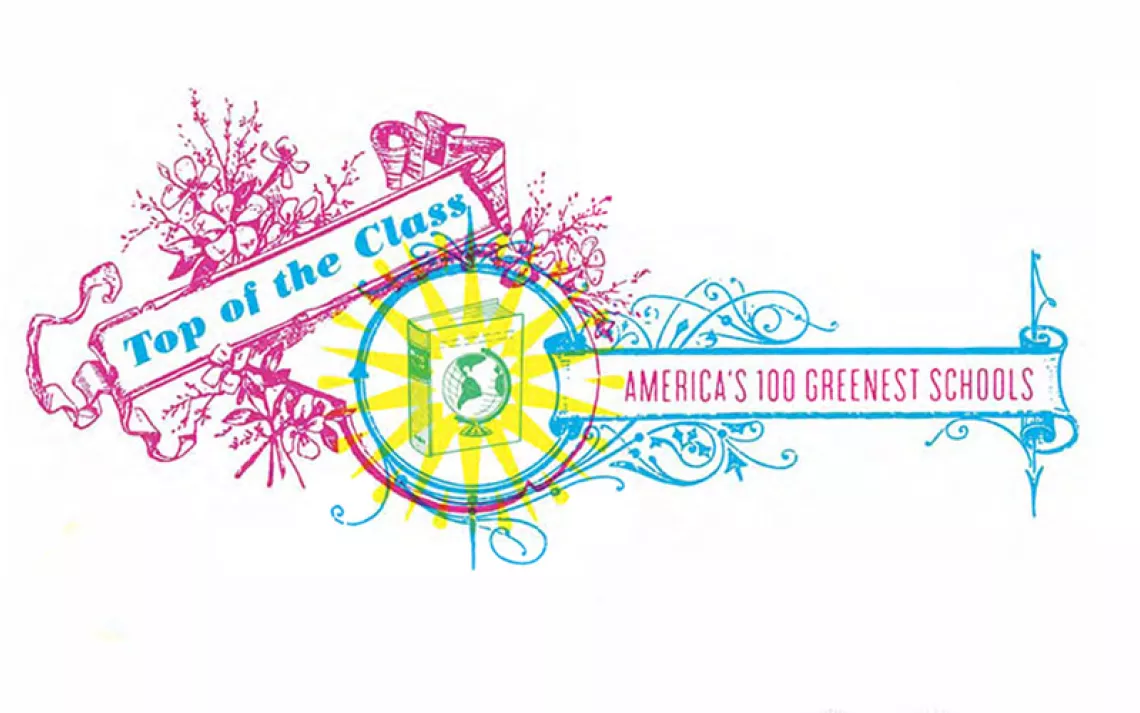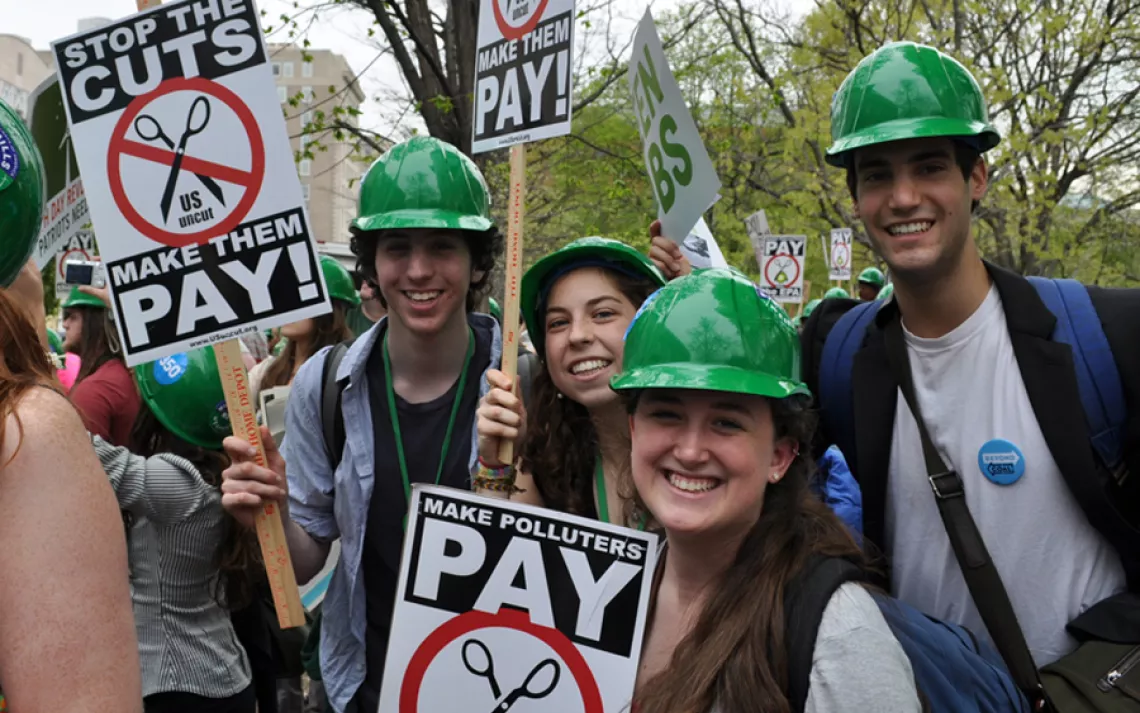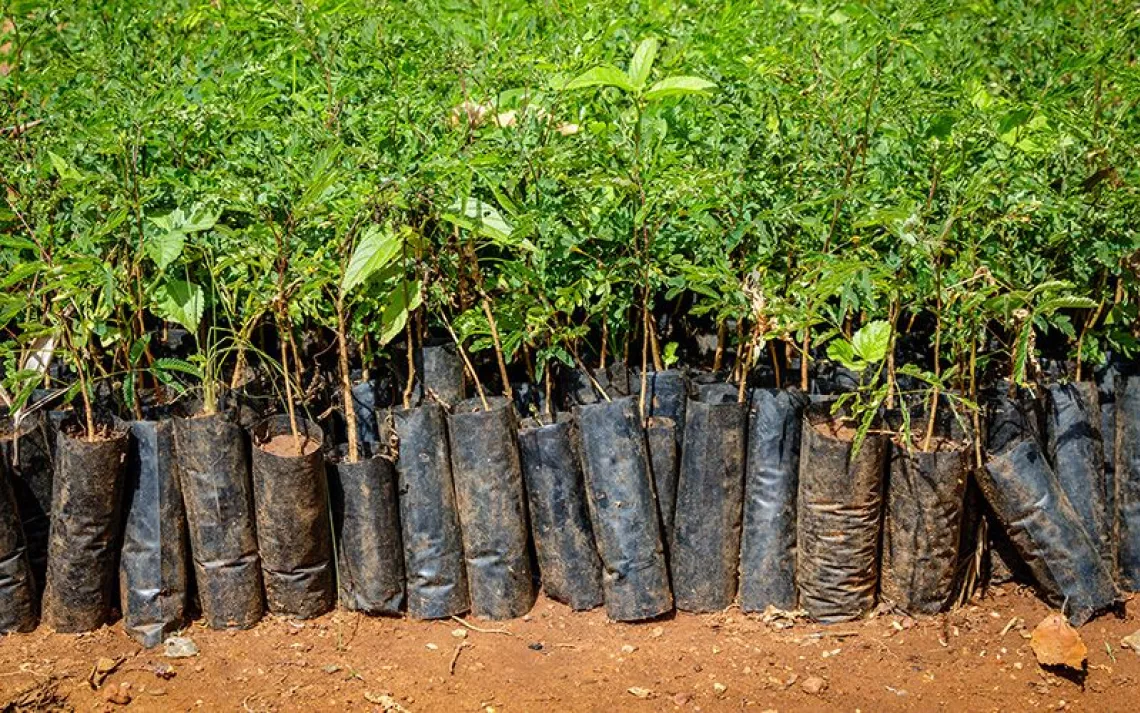The Top 20 Coolest Schools 2021
Get to know today's most sustainable colleges and universities
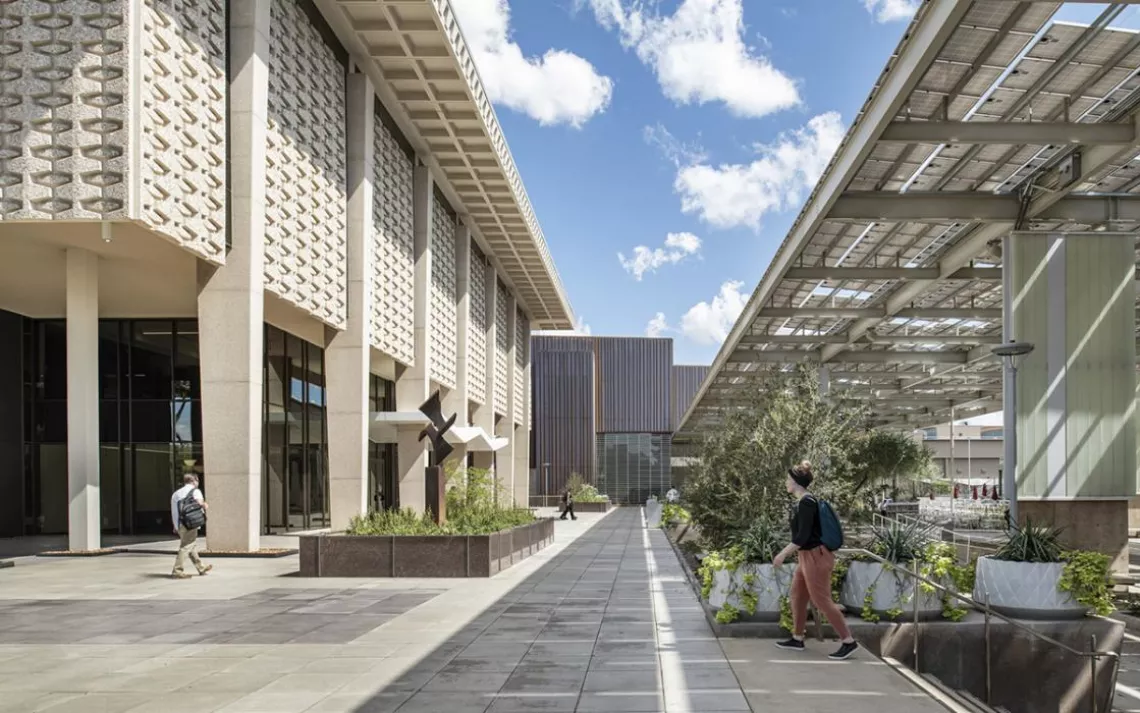
The Hayden Library Reinvention at Arizona State University is LEED Platinum certified.
The Top 20 | All 328 Schools Ranked | Methodology | FAQ | More Cool Schools
If the coolest schools of 2021 had a motto, it might be "Never let a crisis go to waste." During a year like no other, these colleges' and universities' sustainability officers took a deep look at how their schools operated and devised new and innovative ways to reduce their schools' ecological footprints. Largely while sheltering in their screens, these campus administrators did the quiet, behind-the-scenes work of getting more sustainable infrastructure in place while developing new ways to engage students and their communities. Despite having to comply with COVID-19 safety protocols that complicated existing initiatives like phasing out single-use plastic bags and takeout containers, they found creative ways to manage or even minimize their waste streams, and even more important, their greenhouse gas emissions. They asked their university communities not how their schools could return to "normal" after pandemic lockdowns but how they could rebuild while fostering more ecologically regenerative and equitable ways of learning and operating.
In our 15th year ranking colleges according to their eco bona fides and environmental commitments, a record 328 schools across the United States and Canada participated in our survey. While each institution on our list demonstrates a deep commitment to addressing climate change, protecting the natural world, and encouraging environmental stewardship, many among the top-scoring schools whose representatives spoke to Sierra made a point of acknowledging that they'll never earn an A+ in sustainability—that sustainability is the very definition of a goal with no end. There's no point at which anyone at any of these schools can rest on their laurels and claim they've mastered living more lightly on the planet. The same, of course, goes for all of us.
At the same time, it's important to honor the good work these colleges and universities have done—so please join Sierra in congratulating the following 20 tremendously cool schools.
Score: 79.61 | Davis, California
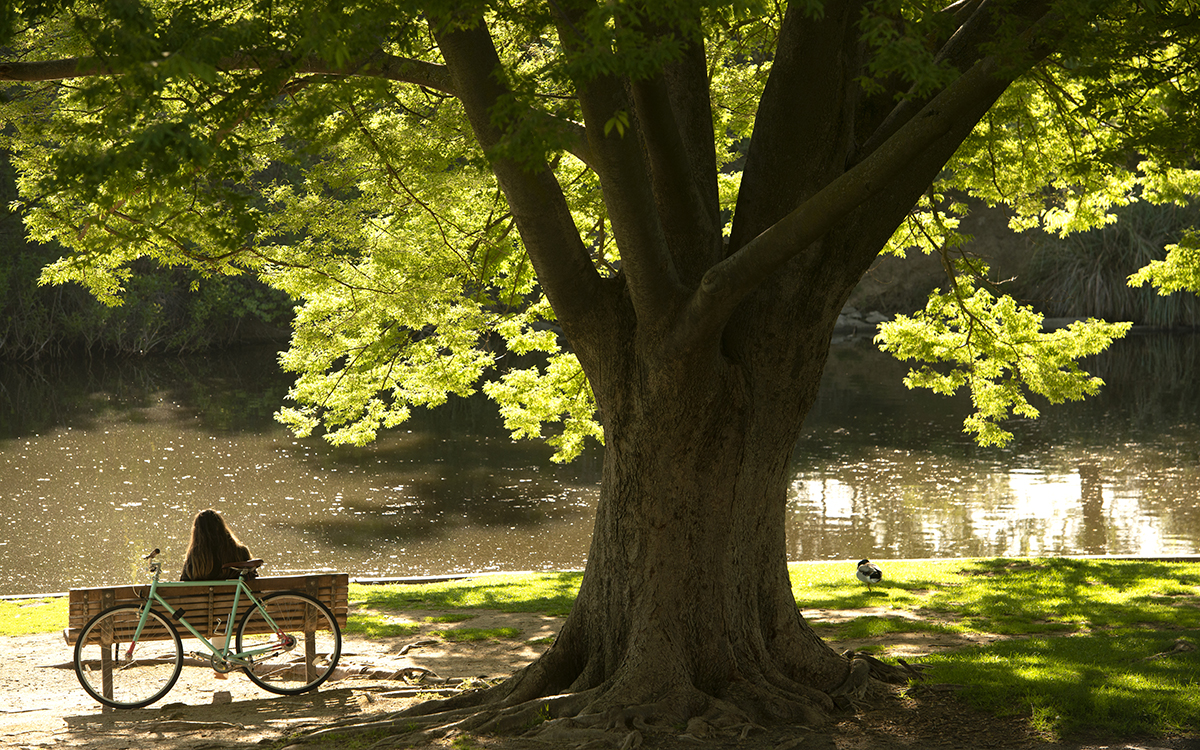
A student takes in the sun with her bike at her side in the UC Davis Arboretum. | Photo by Gregory Urquiaga
The Aggies used the pandemic lockdown to launch large-scale construction of the Big Shift—an infrastructure project that will ultimately position UC Davis for full electrification of its heating system. Administrators also secured funding to electrify more of the student-run bus fleet, bringing that count to 11 out of 14. During the first year of the pandemic, UC Davis Sustainability created a new Green Home Office/Study Space Certification in its Green Workplace series. Meanwhile, a Workplace Reimagined committee is researching the environmental benefits and impacts of remote work. UC Davis is developing a Living Landscape Adaptation Plan that looks 70 years into the future to transition the campus landscape to climate-resilient plant species. The Aggie Buy online procurement system automatically flags green products, making more sustainable purchase decisions no-brainers for faculty and administrators.
Score: 79.90 | Washington, DC
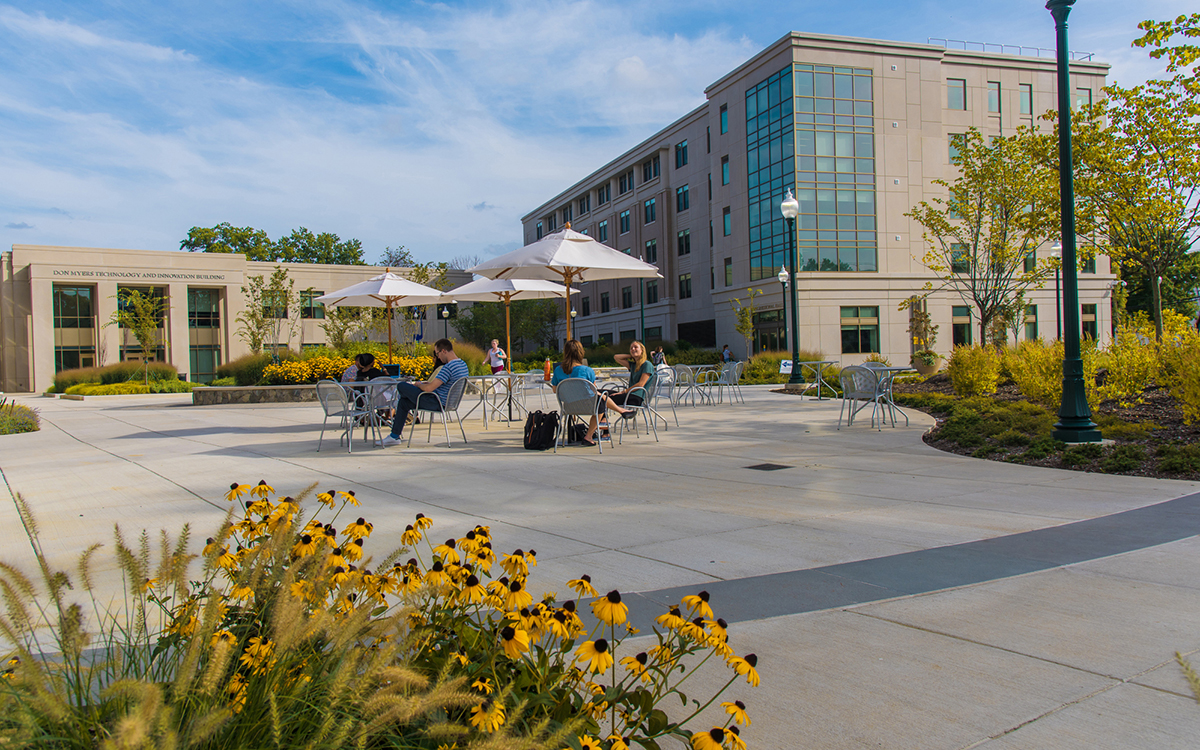
American University's East Campus, now home to four LEED-certified buildings, was previously a 900-space surface parking lot.
After going carbon-neutral (with help from offsets) in 2018, the administrators at American spent two years engaging students and faculty on where to focus moving forward—all of which has been integrated into a newly unveiled Sustainability Plan. The plan includes methods to further shrink AU's direct emissions—through new solar projects, energy-effective construction requirements, greening campus hardscapes, eliminating single-use plastics, and creating circular office supply and campus furniture ecosystems. Throughout lockdown, AU kept the campus community engaged by hosting virtual "Sustainabili-TEAs" and an environmental-justice-themed book club. On last April's annual Campus Beautification Day, AU invited the community to plant flowers and trees and to help build upon the campus's elaborate green roof system. On Earth Day 2020, American completed the process of fully divesting from public fossil fuel companies.
Score: 80.04 | Amherst, Massachusetts
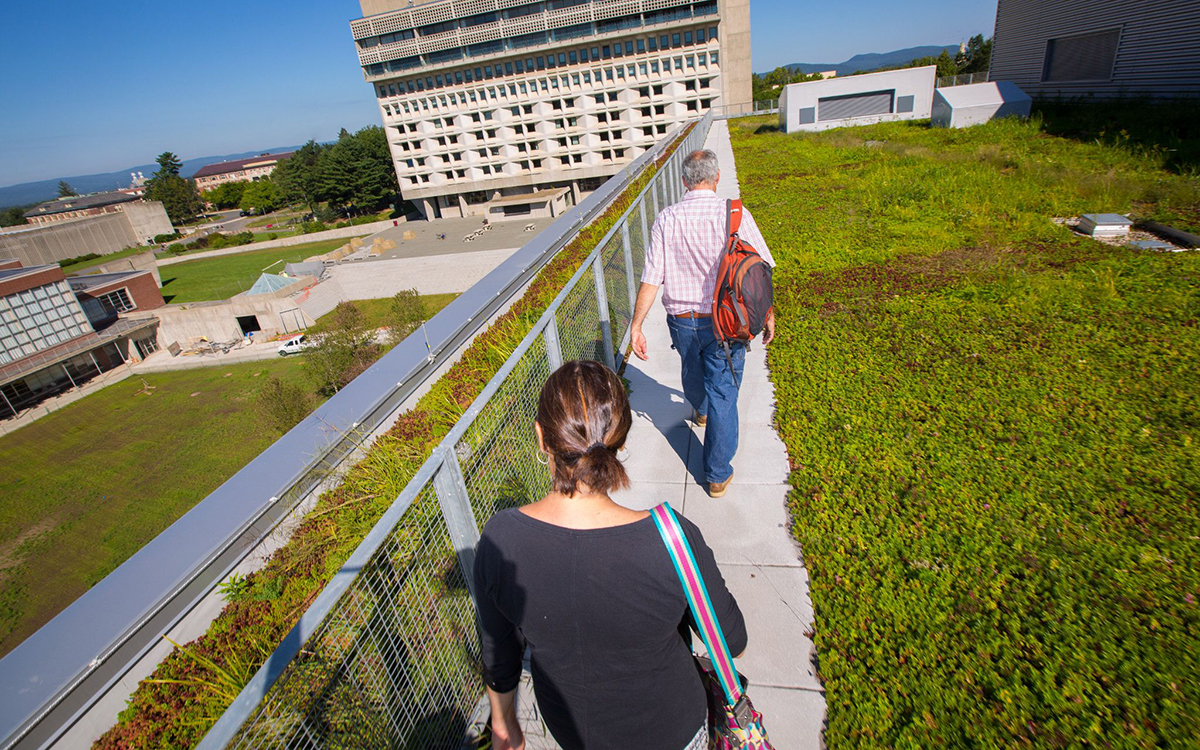
A view of the Campus Center from the green roof on the new Integrative Learning Center. | Photo by John Solem/University of Massachusetts Amherst
The home of Massachusetts's first EV fast-charging station (installed in 2014) is transitioning its campus fleet to all electric vehicles, and adding to its solar parking canopies and battery storage systems. An early adopter of the Carbon Literacy Project, UMass is hiring 12 undergrads to facilitate a certification program through which students and faculty can enroll in an eight-hour training focused on the costs of carbon pollution as well as individual, community, and policy solutions to the climate crisis. For the past 18 months, a task force composed of students, faculty, and staff has been developing a carbon-mitigation plan to create pathways toward eliminating all campus emissions—with help from low-temperature hot water conversions, inter-building heat trading, and renewable geothermal systems. UMass just added a sixth station for ValleyBike, a regional bike-share program serving eight communities in Massachusetts's Pioneer Valley (the program offers a student discount for membership and an equity access pass program). What's more, the Minutemen just got a grant for grad students from all departments to research the nexus of energy and equity in the era of climate change.
Score: 80.97 | Carlisle, Pennsylvania
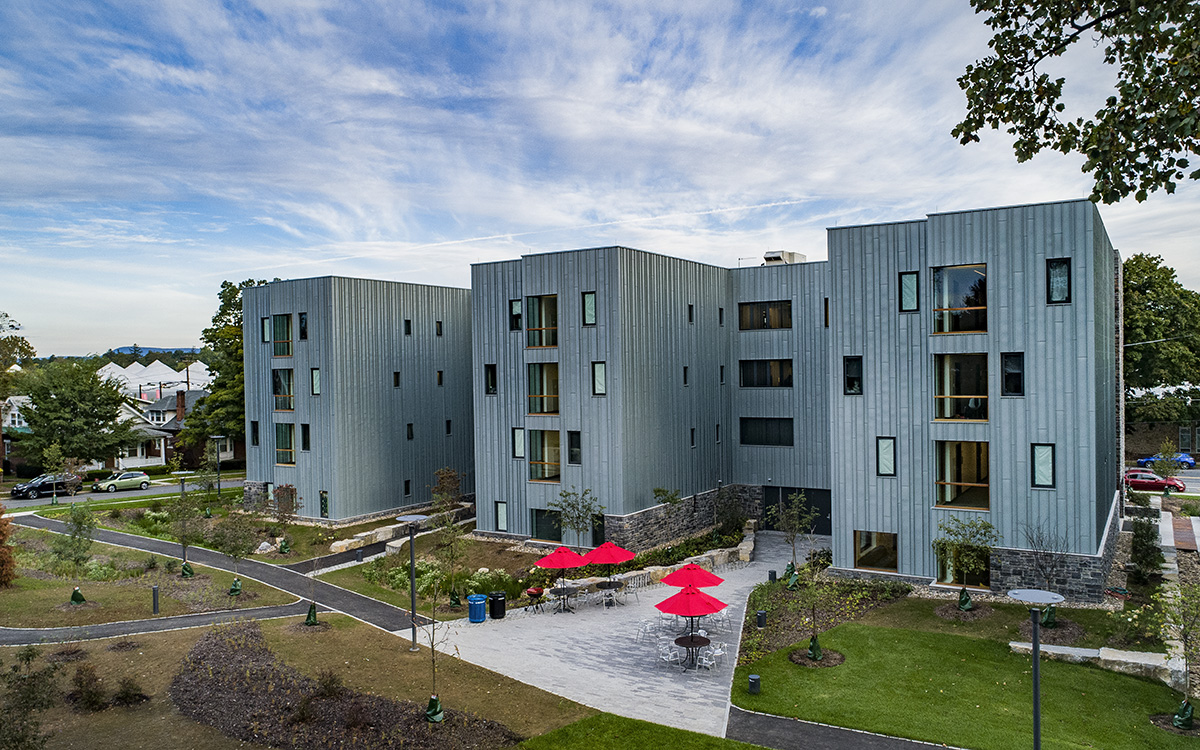
Dickinson College's High Street Residence Hall is the first LEED Platinum–certified building associated with an institution of higher education in Pennsylvania. | Photo courtesy Dickinson College
During the early-pandemic lockdown, the very green Red Devils reduced their GHG emissions by 35 percent with help from a renewable-power purchasing agreement, a three-megawatt solar system, and an LED retrofit. For years, Dickinson's on-campus organic farm has been doing pilot-scale work, processing food waste from the cafeteria and manure waste from its small livestock operations through an anaerobic digester to create biogas. Now, Dickinson is scaling that operation and will eventually produce enough methane biogas to produce electricity to not only power a neighboring dairy farm but to also sell carbon-free electricity to the local electric utility. Dickinson students have spent two years working with the local municipal council to develop a climate-action plan consistent with the Paris Agreement and are now helping the local county planning department do the same. This November, Varshini Prakash, cofounder of the Sunrise Movement and winner of Dickinson's Rose Walters Prize for Global Environmental Activism, will be on campus advising students how to take meaningful action to address the climate crisis.
Score: 81.63 | Santa Barbara, California
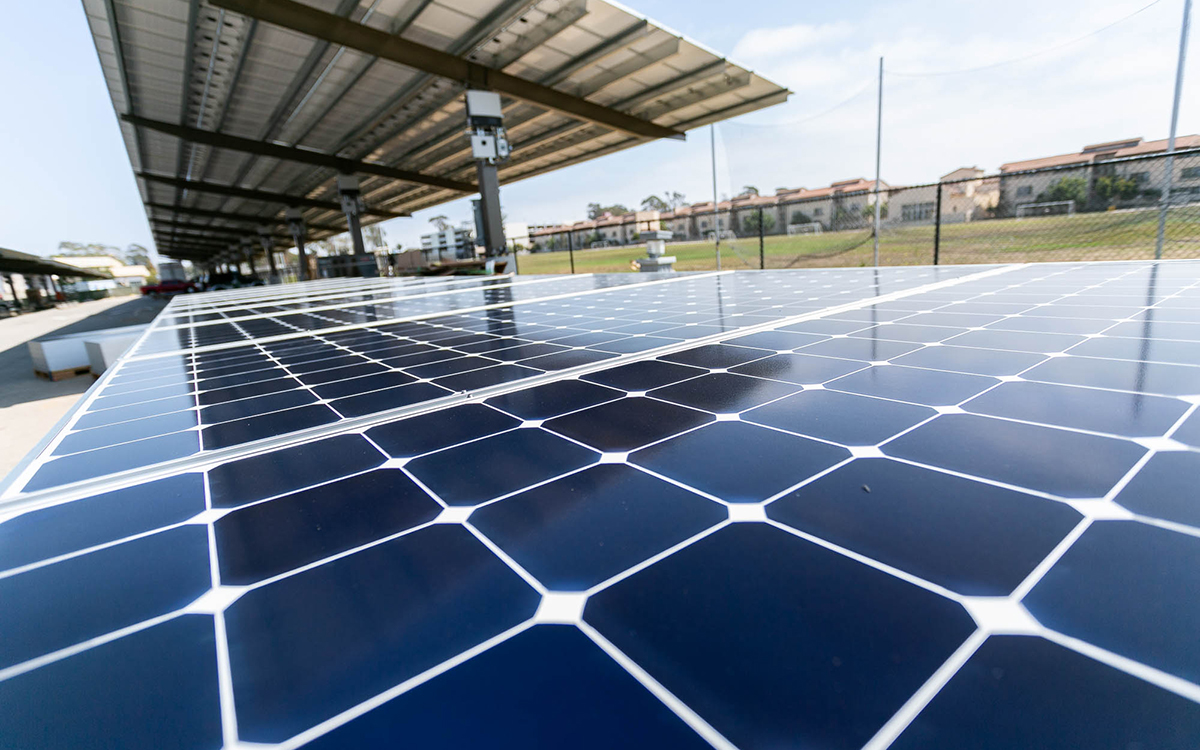
With an average of 10 months of sunny days per year, UC Santa Barbara's solar installations generate more than one-third of the campus’s peak electrical demand. | Photo by Matt Perko
Throughout the pandemic lockdown, the Gauchos kept the student body engaged in its Edible Campus program through virtual gardening classes, plus a food-justice reading group. Back on campus, UCSB substantially expanded bike parking, adapted both its Green Offices and Green Labs certification programs for remote work spaces, and committed to purchasing only fossil-fuel-free energy (solar, wind, or hydropower). Faculty hosted a virtual climate justice symposium for transforming curricula—they welcomed other faculty and grad students from the UC and Cal State systems as well as community colleges to discuss ways to partner with local organizations to create more sustainable syllabi and to ramp up climate-justice themes in class. Right before going into lockdown, UCSB enacted a zero-emissions electricity policy, prompting a 50 percent drop in emissions, and also broke ground on its Institute for Energy Efficiency. We're thrilled to see UCSB back in our top 20 mix (the school last appeared here in the 2013 Cool Schools rankings).
Score: 82.01 | Pittsburgh, Pennsylvania
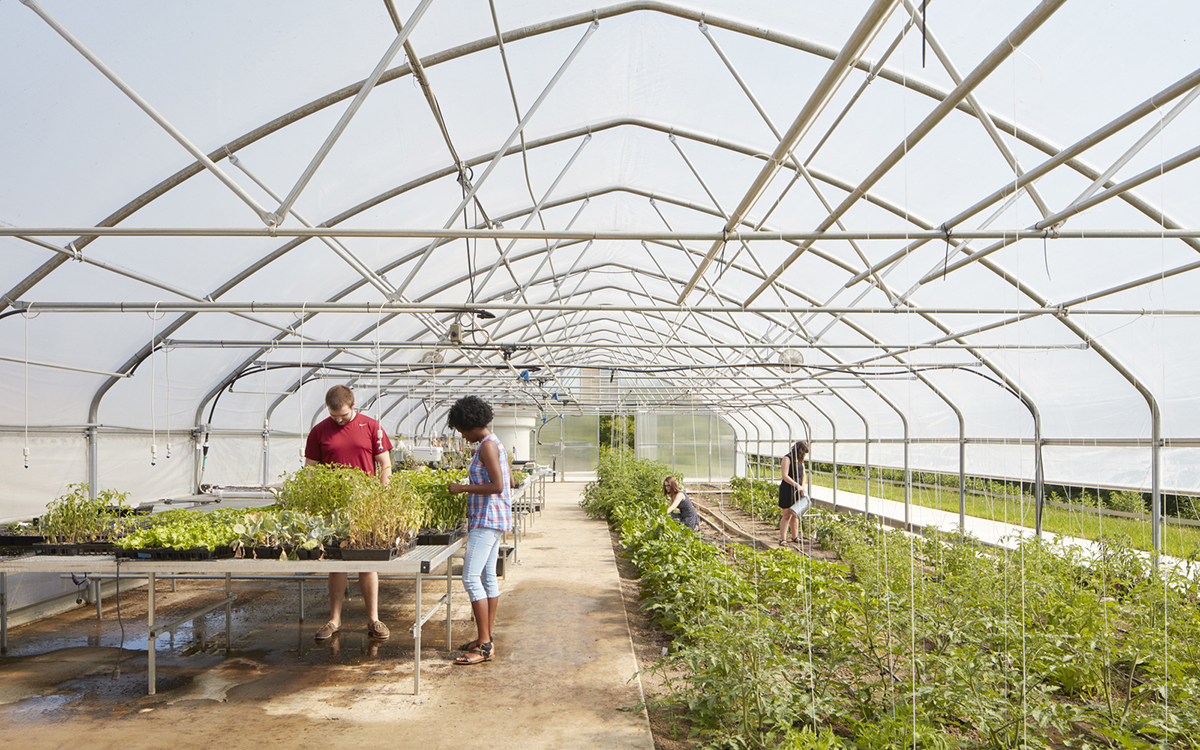
Chatham University
At Chatham's Eden Hall Campus, most students are candidates for sustainability and food studies degrees, and many are active in clubs like the Green Team, the Waste Warriors Composting Collective, and the Food and Water Access Group. On Chatham's campus—which includes two native plant gardens, a work-and-pick garden, agroecology fields, a solar-thermal greenhouse, rainwater-capture systems, chickens and pygmy goats, and aquaculture labs—nonorganic pesticides have been prohibited since 2000. It's part of this Bee Certified Campus's pollinator-protective campaign. In the past year, Chatham has constructed a vertical-axis wind turbine that started as a student's thesis project and is now managed, along with Chatham's microgrid, by students. The turbine provides energy to Chatham's fields, where students grow food for both the campus dining hall and the local food bank.
Score: 82.99 | Seattle, Washington
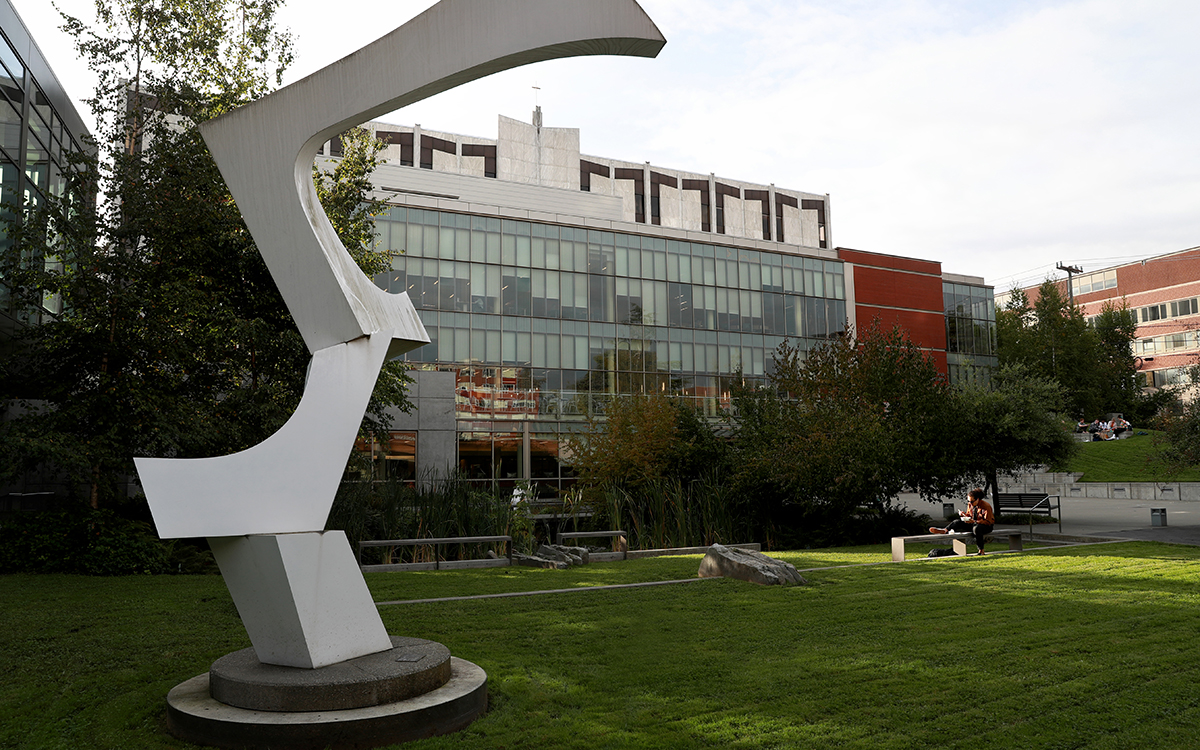
Photo by Yosef Kalinko
By Earth Day 2022, Seattle University aims to become officially carbon-neutral for all scope 1 and 2 emissions, with help from heat recovery options, a fully electrified vehicle fleet, and offsets for approximately 3,300 metric GHG tons. Last school year, SU diverted 76,000 pounds from its waste stream (thanks to comprehensive sorting education) and added five EV charging stations as well as a food pantry for food-insecure students. In the past year, engineering students proposed plans to retrofit two 1900s-era campus buildings with solar panels, electric heat pumps, rainwater-supplied toilets, and more-efficient furnaces. Student fellows are busy studying campus bee populations and pollinator pathways (Seattle U is an urban wildlife sanctuary) as well as student-led fossil fuel divestment movements across the country (in an effort to create a blueprint for students trying to sway their own university admins). Speaking of which, Seattle U is ahead of schedule on its 2018 vow to fully divest its endowment of fossil fuels over the next five years (and on track to become the first school in Washington State to do so). It all adds up to an impressive six-spot leap since the 2020 rankings.
Score: 83.20 | Quebec City, Quebec
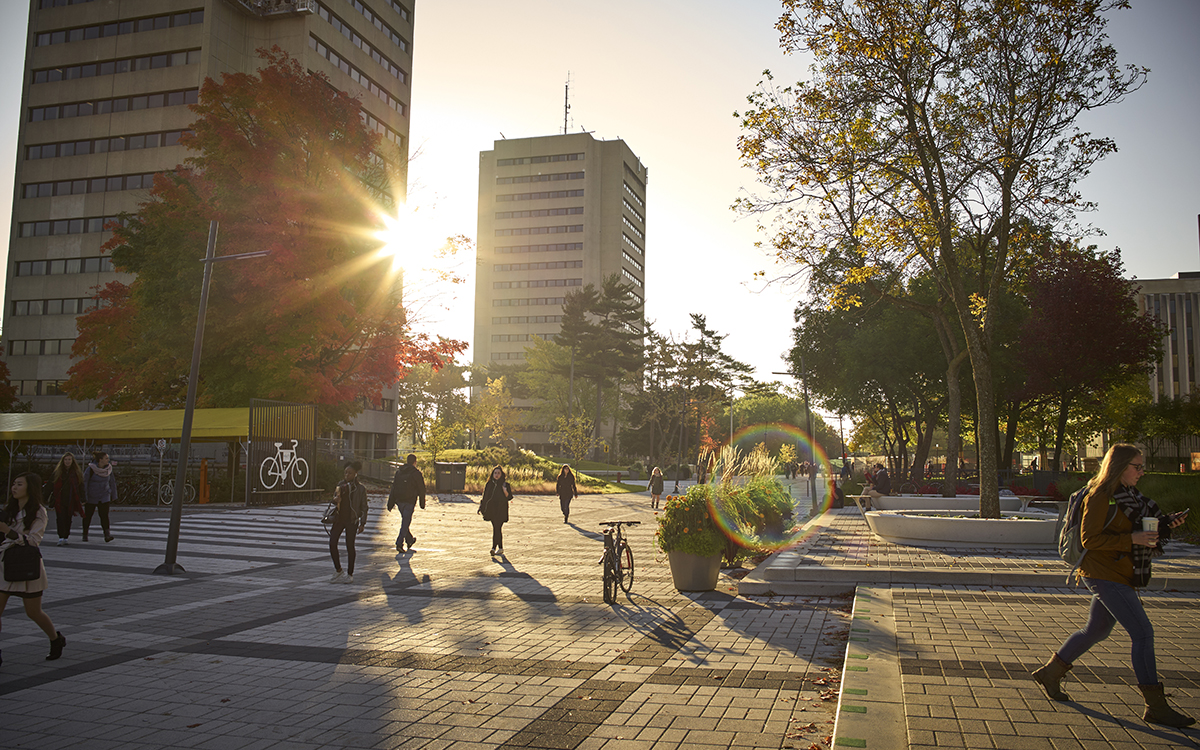
Fall semester. | Photo courtesy Université Laval
In July, the green francophone giant (serving 45,000 students) known as ULaval launched the International Student Network for Climate Action, which brought together student leaders from across the globe to exchange best climate-action practices. The summit was a great success, and now any student from any country can apply to become a member. When learning went remote last year, Laval teachers created a directory of digital educational resources related to sustainability and made it accessible to the entire campus community. Last year also saw 35,211 students enroll in 392 sustainability-oriented courses. Since adopting a Responsible Investment Strategy in 2019 (with a goal of halving its investment portfolio's carbon footprint by 2030), Laval has quantified all investments and mandated low-carbon indices for new investments.
Score: 83.62 | Waterville, Maine
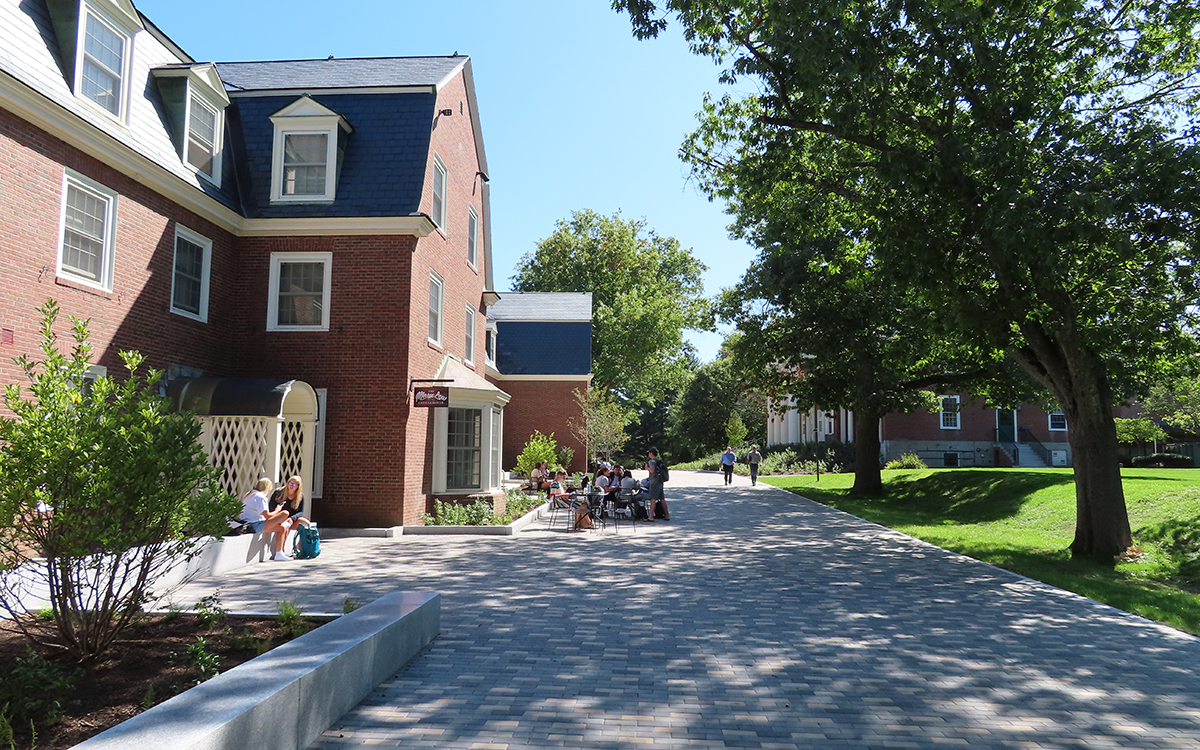
The conversion of Runnals Drive to a landscaped pedestrian walkway has enhanced the experience of the outdoors for students. | Photo by Klopfer Martin Design Group
You could say Colby wears its sustainability values on its sleeve—during the course of the early-pandemic lockdown, staffers rewilded approximately 15 acres of former campus lawns and turned them into meadows of native grasses. A similar project is underway to convert a parking lot into a green outdoor performance area. Colby also converted some vehicular roadways into pedestrian and bike paths with landscaped outdoor seating areas. When dining services closed last year, staffers used their time to expand the school's organic garden and identify nearby clusters of wild berries to preserve. Through use of on-campus solar power and small-scale biomass energy and sourcing all of the rest of its electricity from renewables, Colby managed to move away from carbon-offset programs in all energy categories except for transportation.
Score: 83.91 | Sherbrooke, Quebec
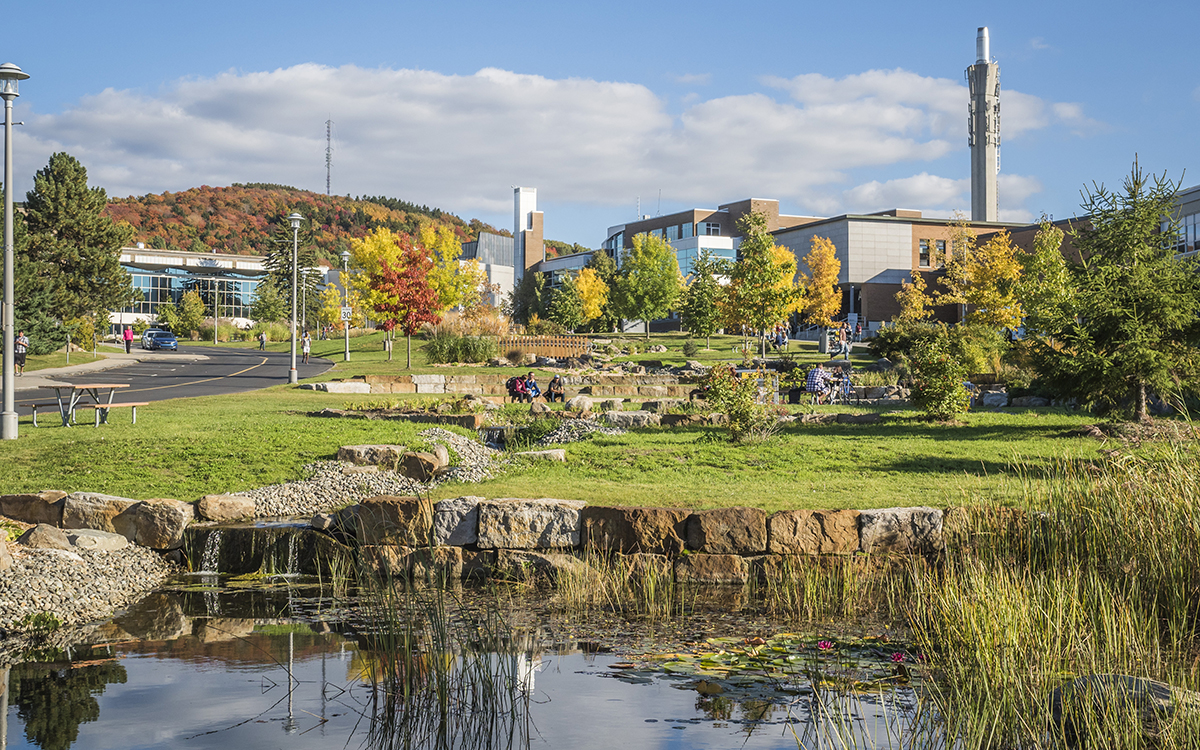
Photo courtesy Université de Sherbrooke
Quebec's Université de Sherbrooke may be the rookie on this year's list, but it modeled Quebec's first universal public transit pass for students, is the first French-speaking Canadian university to be designated as a Fair Trade campus, and was Quebec's first bee-friendly campus. The school also participated in the creation of the International Dark Sky Reserve of Quebec's Mount Megantic by reducing light pollution and is taking steps to help the city of Sherbrooke's largest park become recognized as a nature reserve. In 2019, a team of 51 law students drafted a bill to regulate the obsolescence of consumer goods after obtaining more than 45,000 petition signatures calling for such a law. More than 110 faculty members are conducting research in sustainable development, and students clubs include a zero-waste committee, a community fridge, a collective garden, and a bike co-op. Université de Sherbrooke offers institutional support by employing students in the school's Green Team and Sustainability Projects Fund.
Score: 84.68 | Fort Collins, Colorado
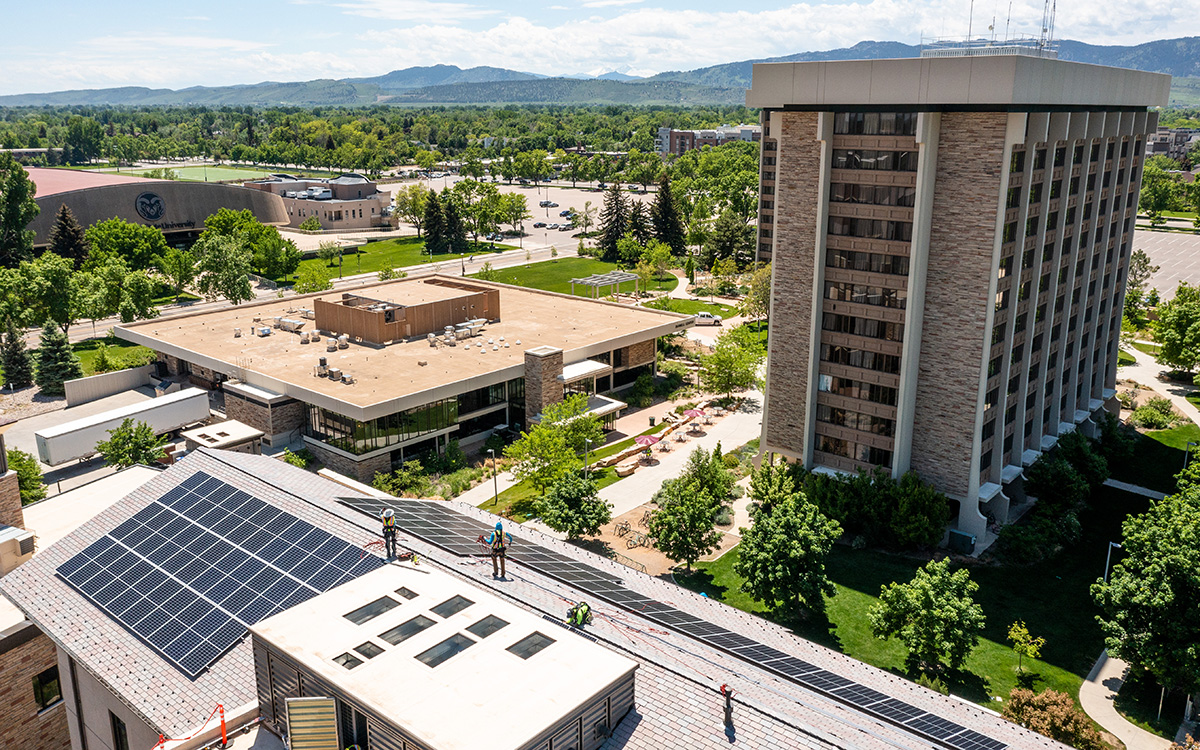
Solar arrays are installed on Alpine Hall, one of 20 arrays slated for installation at Colorado State University in 2021. | Photo courtesy Colorado State University
The long-cool Rams are in the process of almost doubling their solar-energy projects, and at one generating site on the agricultural campus they're addressing solar energy land-use conflicts by grazing sheep below the array. (At others, they're researching which plants grow best below solar panels.) A new curriculum innovation grant incentivizes instructors to integrate complex sustainability topics into existing courses (like chemistry and science writing) or develop new ones (hence "the sustainability of animal protein"). During lockdown, the Rams installed a big geothermal exchange system beneath their intramural athletic fields to run Moby Arena—the sports complex can now be heated and cooled via ground-source heat rather than natural gas. Students participating in the horticulture center living lab now grow enough greens to supply not only campus dining halls but also a local restaurant that serves food-insecure community members for little or no cost.
Score: 85.30 | Durham, New Hampshire
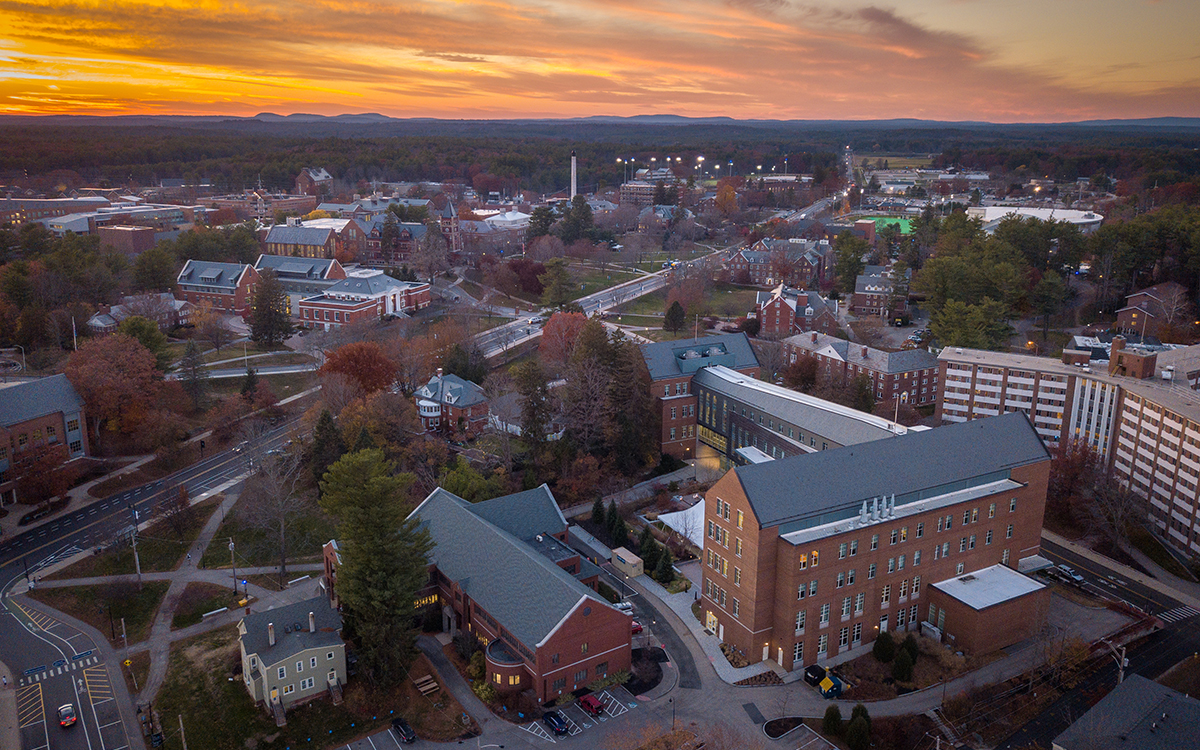
Aerial view of the University of New Hampshire, Durham, campus. | Photo by Scott Ripley
Several years ago, the home of the nation's first university sustainability office launched a clinic that trains students in B-Corp certification methodology and matches them with local companies seeking to become certified. This year, the Wildcats will unveil the Carbon Clinic, through which students use the Sustainability Management and Analysis Platform—a tool developed by UNH and now used at more than 500 colleges nationwide for carbon accounting—to help local entities conduct greenhouse gas inventories and develop climate action plans. The new UNH Sustainability Awards acknowledge and fund the environmental initiatives of students, staff, and faculty. Winners include dining and hospitality leaders who found more ways to source local foods, an economics professor who's developed teaching materials about the economics of climate change, and an agroecology professor working with students in an experiential course studying agricultural tunnels that could extend the growing season for year-round local food production. Meanwhile, UNH's Anthropology department consulted with local Indigenous leaders to launch an Indigenous studies minor.
Score: 85.68 | Storrs, Connecticut
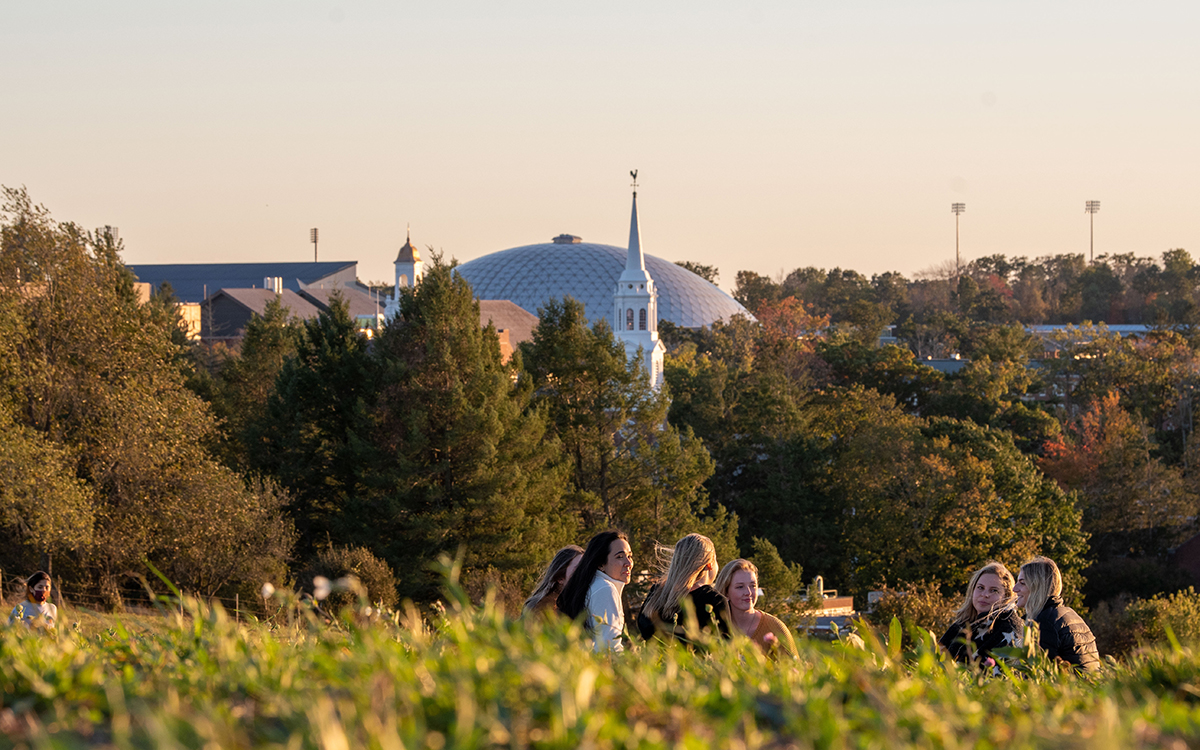
Taken from the university's iconic Horsebarn Hill and Agricultural/East Campus, UConn students gather outdoors with some of the core campus skyline rising through the trees in the background.
Holding strong at number eight again this year, the Huskies are racing to become carbon neutral, sans offsets, by 2040. To that end, UConn will be retiring its gas generator (in favor of geothermal and solar and power-purchase agreements) by 2035. The most popular class during lockdown was a pop-up climate-action course taught by multiple faculty; last spring, more than 1,000 students participated virtually. The UConn sustainability environmental justice toolkit, which was developed by a recent grad, provides voluminous resources for aspiring advocates. One of the Huskies' most popular socially distanced rendezvous was Haunted HEEP, a guided haunted Halloween hike through UConn's 165-acre Hillside Environmental Education Park, which functioned as a celebration of nature's power to address eco-anxiety as well as pandemic-related isolation. Now that students are just about fully back, UConn's spirited inter-residence hall competition to conserve water and energy—an endeavor spearheaded by paid student eco-captains—is back in full force.
Score: 86.64 | Merced, California

University of California, Merced
To graduate from the UC system's smallest and youngest outpost, students must earn a sustainability badge through coursework or extracurriculars. UC Merced is also a founding member of the UC system's Clean Power Program, through which all eight campuses can purchase renewable energy at a more cost-effective rate. The Bobcats are now looking into capturing methane released from landfill and secured state funding to start a research farm to develop agriculture technology that's both farmer- and worker-friendly and improves productivity along with sustainability. Along with the massive campus greenhouse, the farm will help supply the Pop-Up People's Pantry, created in partnership with the city in wake of COVID's economic fallout. UC Merced researchers have recently received grants to examine the climate change impacts of wildfires and to study how fires impact the California coast. For Earth Day, the campus partnered with London's Shakespeare Globe Theatre to host a Climate Emergency Conference that drew parallels between The Bard's works and the climate crisis.
Score: 87.80 | Berkeley, California
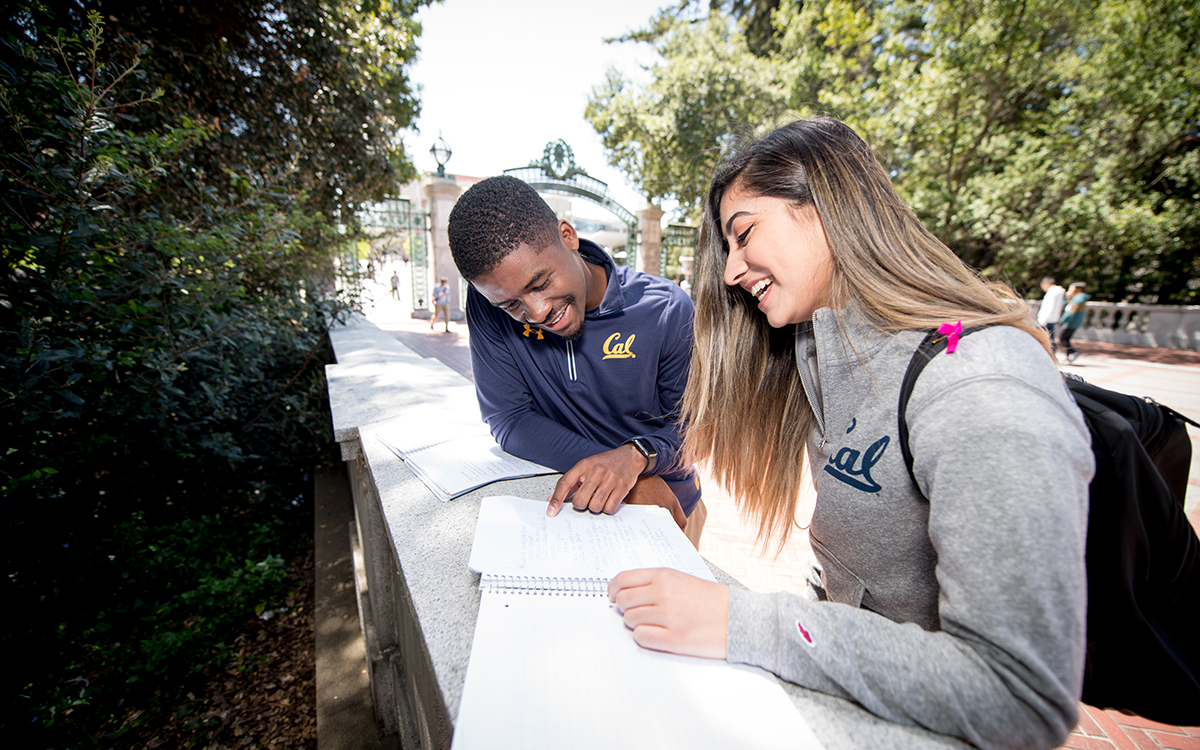
Berkeley students compare notes overlooking Strawberry Creek, a thriving campus natural feature experienced by 3,000 university students each year for education and research. | Photo by Keegan Houser
The Golden Bears jumped a whopping seven slots from their 2020 ranking and emerged from lockdown with a campus sustainability plan to fully decarbonize the campus by 2028. Given Berkeley's location in drought-ravaged California, the school also developed a water-resilience plan that has conservation and stormwater control measures and identifies that an on-campus wastewater treatment plant could supply the university with 20 to 30 percent of its water. As part of a clean-energy campus initiative, Berkeley announced plans to decommission its natural gas plant and eventually electrify the campus. Almost 50 percent of Berkeley's courses have a sustainability focus or bent, and on the way to their classrooms, students stroll through landscaping that is 95 percent organically managed. Berkeley is beginning to look into enhancing rewilding efforts that will support biodiversity, including steps to restore Strawberry Creek, one of its great natural features.
Score: 88.72 | Syracuse, New York
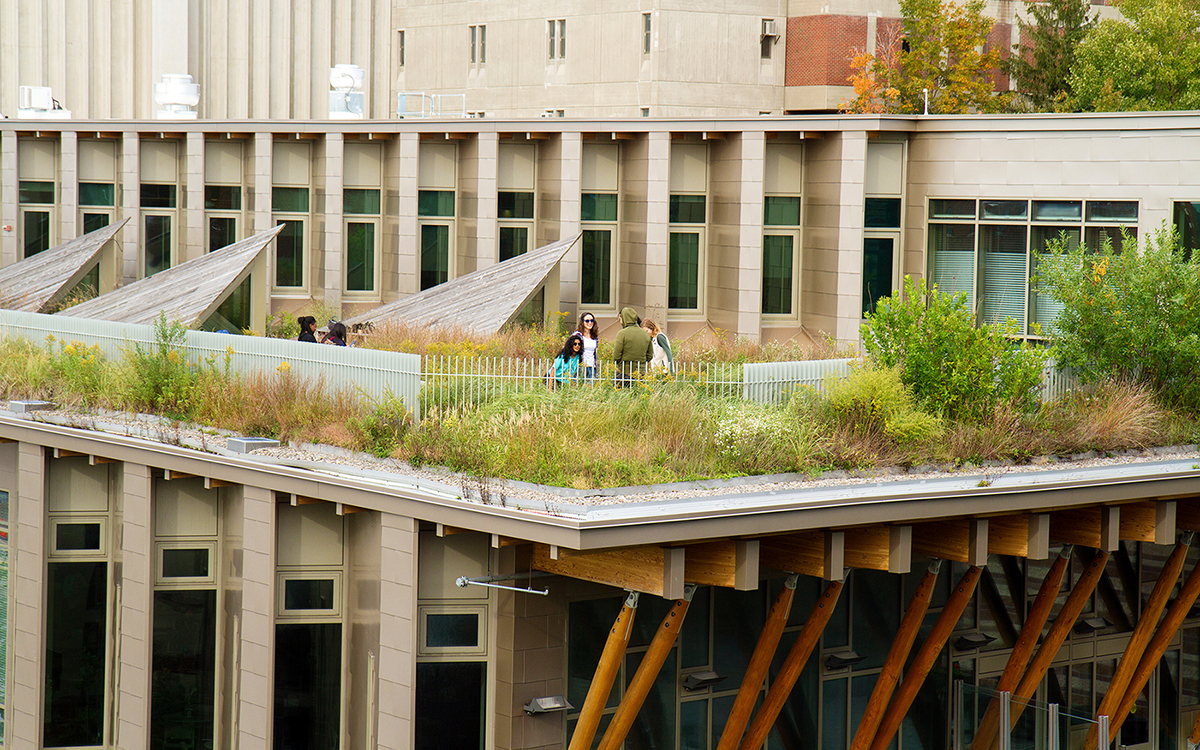
The Gateway Center's green roof on the main ESF campus serves as a distinctive landscape as well as a research and demonstration project. It's also a great place for students, faculty, and staff to gather. Many of the plant species are state-protected, and some are quite rare, occurring naturally in just one to a few places in New York State. | Photo courtesy SUNY ESF
Last year, the coolest school within New York's extensive state university system broke ground on the NYS Center for Sustainable Materials, through which faculty, staff, students, and other partners coordinate statewide waste-management campaigns and work to develop superior biodegradable plastics and better methods for recycling materials such as glass. Students and faculty are studying the New York waste stream as well as behavioral barriers to recycling (it's part of why SUNY ESF also launched a Recycle Right New York campaign last year to educate people about best practices). Ever since New York passed its Climate Change Community Protection Act, the Mighty Oaks have been working with state agencies to improve carbon sequestration through forestry practices. The school has also influenced state policy in terms of green purchasing and is working to create the SUNY Institute for Climate Change, through which all 64 campuses can focus on climate adaptation and mitigation actions.
Score: 88.97 | Ithaca, New York
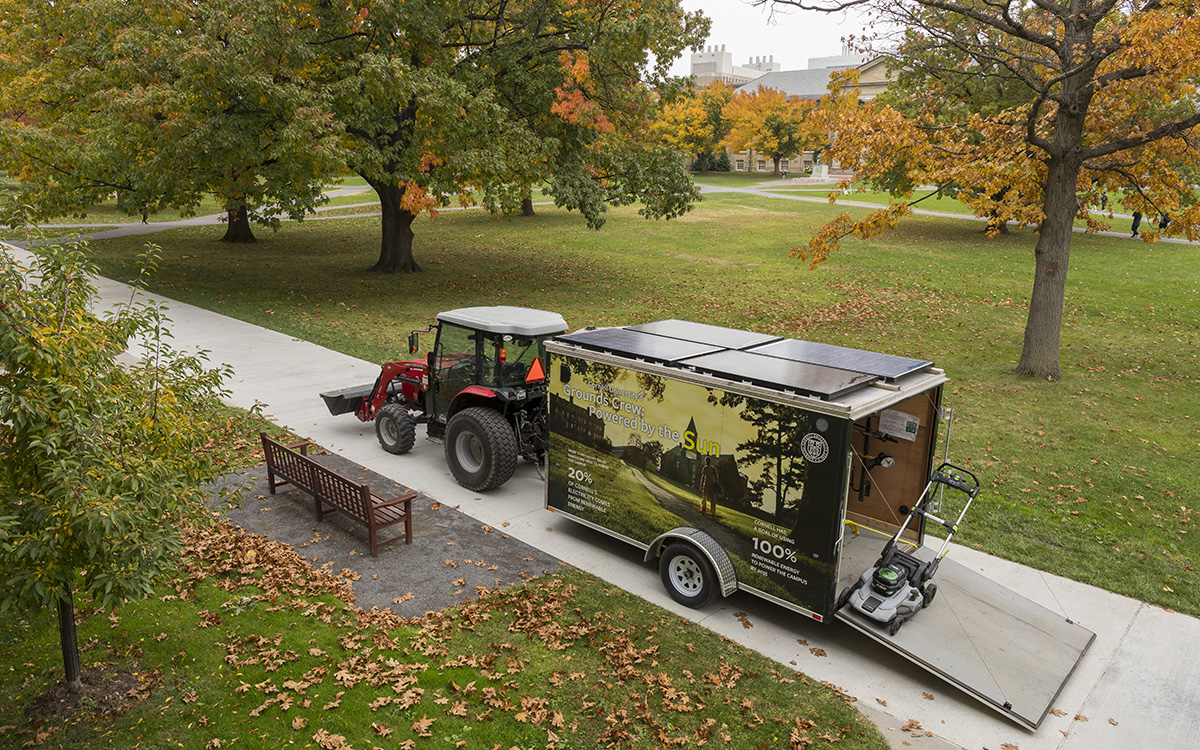
Cornell University
Advancing an impressive eight spots this year, the coolest Ivy League campus added a one-megawatt solar rooftop array—Cornell's largest of its 16 on-campus solar projects. The school also launched a dashboard to analyze the effectiveness of all energy-conservation projects over the past 20 years. On the social front, students and faculty worked with leaders of Gayogo̱hó꞉nǫ' (the Cayuga Nation), who originally called Cornell's campus home, to develop a formal Indigenous land acknowledgment, which is how they now kick off every public event. The Touchdowns also secured funding to launch a paid, year-long Women Leaders in Sustainability Fellowship designed to funnel women into executive sustainability positions (while the sustainability field is dominated by women, it is still largely led by men). A new fund called ClimateX encourages faculty to create interdisciplinary teaching opportunities that at once instruct and create paths to address the climate crisis. Through ClimateX, for instance, students are utilizing Cornell's farm fields to test carbon-sequestration methods.
Score: 89.63 | Kamloops, British Columbia
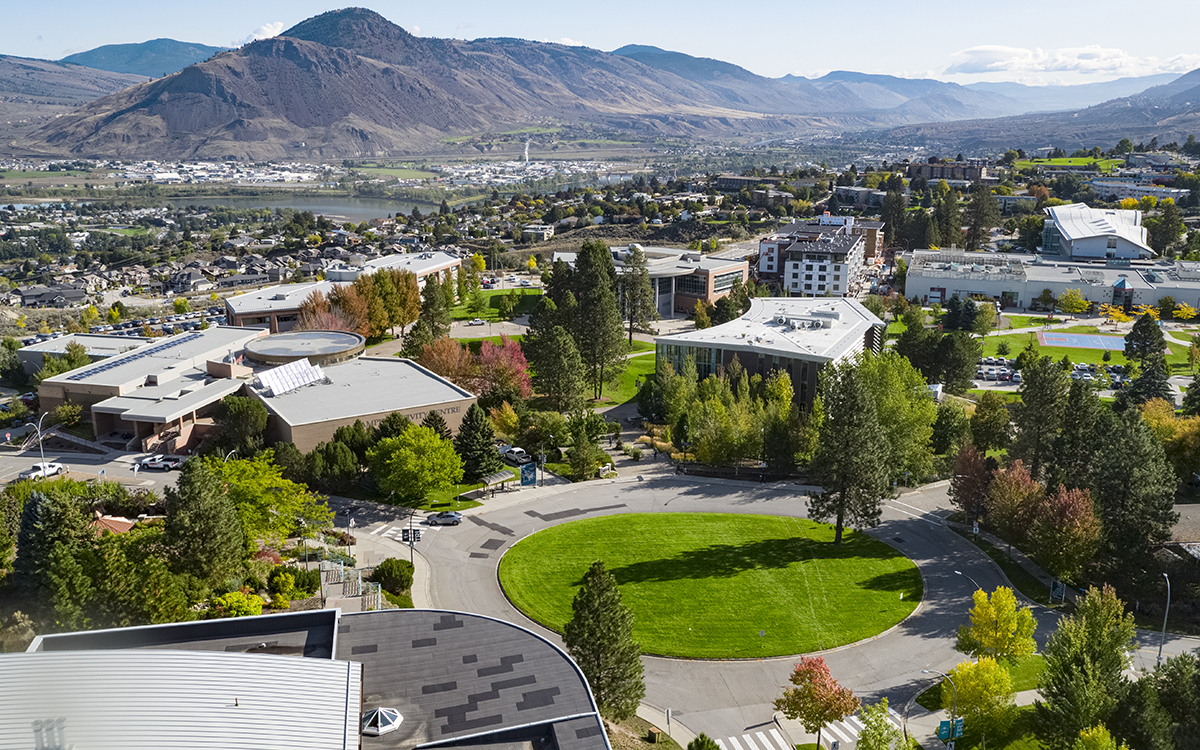
Aerial view of the Thompson Rivers University Kamloops campus. | Photo by Alex O'Daly
The first Canadian school to break into our "Coolest" list three years ago hasn't lost its innovative touch: This month, it's launching a tree-planting, care, and preservation program through which volunteers commit to caring for a tree for one to three years. TRU's Single-Use Item Elimination Task Force kicked off a unique reusable cutlery program that works with a local vendor to create storage bags from unusable cotton poly sheets and fills them with thrift store knives, spoons and forks. Not only are all new buildings LEED Gold, but TRU analyzes migrating birds' flight patterns and prevents avian crashes by covering "problem windows" in a film, so birds don't smash into them. During the lockdowns, TRU sustainability educators created one-minute sustainability stories in video form—micro-bites about various sustainability issues that they’re passionate about. And thanks to a campus electrification project that will replace all this chilly campus's natural gas boilers an electrified campus district energy system), the university is on track to reach carbon-neutrality by 2030.
Score: 89.95 | Irvine, California
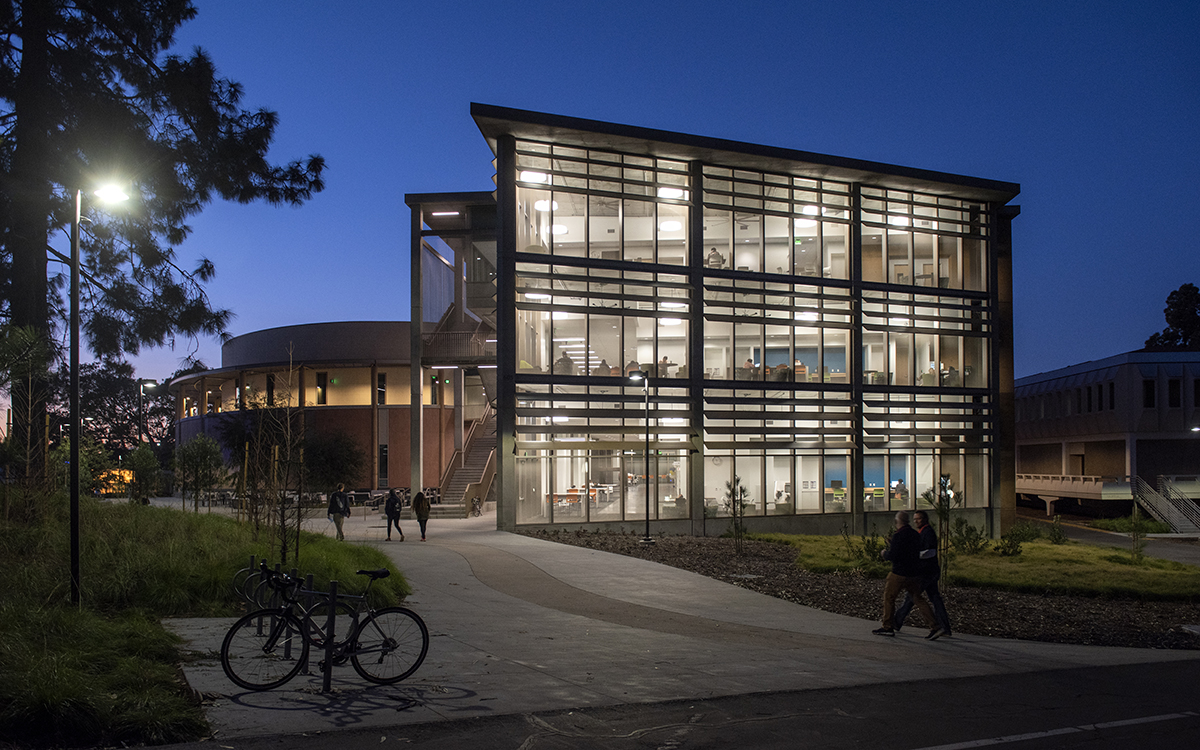
The Anteater Learning Pavilion, one of the campus's newest certified LEED Platinum buildings, is dedicated to interactive learning. | Photo by Steve Zylius/UCI
The Anteaters are in their own category in that they've ranked among Sierra's top 10 Cool Schools for 12 years in a row. And for good reason: UCI offers more than 150 sustainability-related programs and initiatives, 21 buildings are LEED Platinum, and the campus Pump2Plug program has been so successful that this summer, Secretary of Labor Marty Walsh visited UCI to learn more about how to implement sustainable vehicle infrastructure. (Since the program's launch in 2016, more than 350 participants have switched to electric vehicles and the campus boasts almost 200 EV charging stations.) In February, UCI became part of Bee Campus USA thanks to a fully student-led effort, and just last spring, students established an Environmental Justice Collective to create a virtual space to discuss ways to align sustainability and social-justice issues. Throughout the pandemic, UCI managed to maintain a waste-diversion rate of 80 percent (same as in Before Times) thanks to education initiatives and advanced sorting measures.
Score: 91.31 | Tempe, Arizona
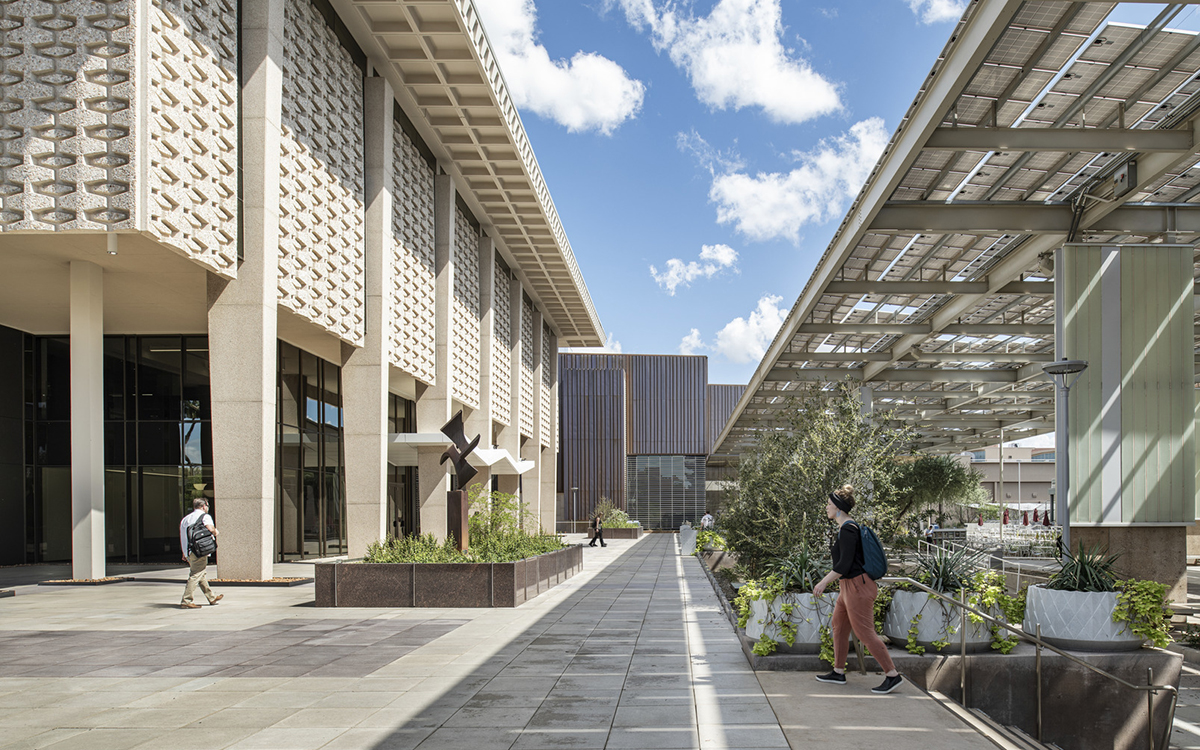
Hayden Library Reinvention at Arizona State University.
We were thrilled to discover that the school most sustainable by Sierra standards (and leap-frogging three spots to take gold this year!) is also one of America's largest. With 129,000 enrolled students, Arizona State University has massive green reach. During COVID lockdown, the Sun Devils launched the Global Futures Laboratory, a transdisciplinary hub serving ASU's School of Sustainability and housing two new programs: the Future of Innovation in Society and Complex Adaptive Systems (through which students and researchers look into uncertainty, scalability, thresholds, and tipping points). In 2021, ASU took the lead on a global initiative to map and monitor coral reefs around the world using robots and AI. With a mission to build academic programming that reflects future needs, ASU launched a new BA in community development, through which students prepare for careers in food security, renewable energy, and sustainable transportation. On the adorable front, several threatened burrowing owls, native to the Sonoran Desert, were welcomed onto the ASU's Polytechnic campus, where students and scientists created habitats—and a living laboratory—for the owls to live and thrive.
 The Magazine of The Sierra Club
The Magazine of The Sierra Club
